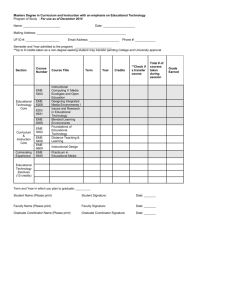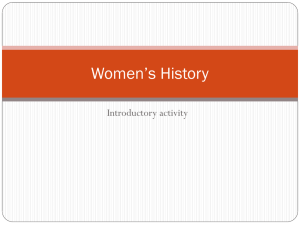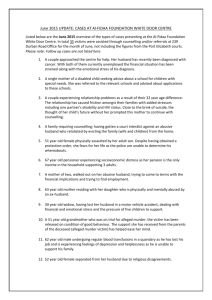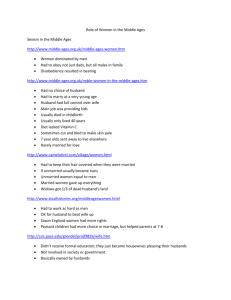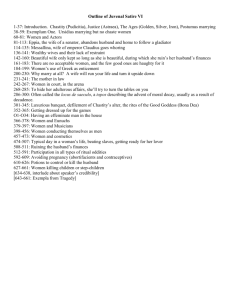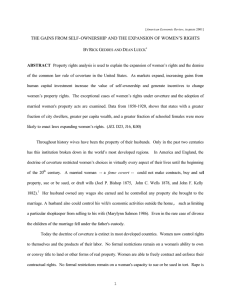Gender Roles - JHC13History
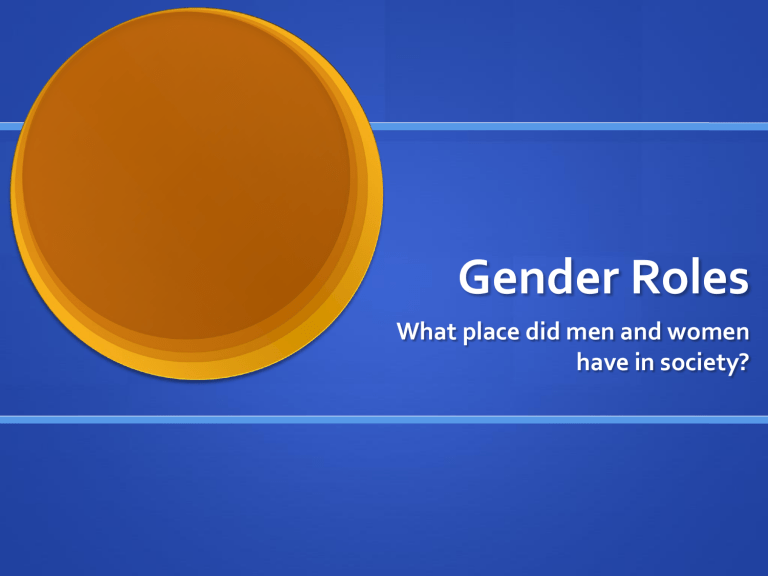
Gender Roles
What place did men and women have in society?
Were men the bosses?
It is very important to realise that men AND women had important roles in EME.
YOU WON’T GET POINTS IN ESSAYS BY SLAGGING OFF WOMEN !
16 th and 17 th C women in England were more restricted than they are today, but compared to other societies they had more advantages.
Men and women had rights under the law (both could sue and be sued)
Both could buy, sell, own property and give it away in their wills.
Both had important roles in the economy, and the raising of families.
Both had , according to the church, an immortal soul
Role of Men in EME
Public life, Church, Family and Economy (4 spheres of life)
Public =
Men had first right to throne (before elder female siblings)
Only men could be in Parliament = also only men could vote in parliamentary elections
All legal officials - judges, jurors, lawyers – were men. Women’s only role was specific to female prisoners.
All military officers were men (women generally had to men’s jobs while they were away fighting)
Men carried most of the burden of public duties, they often had to act for their wives in areas where a single woman would do it herself
Reinforces idea of being subject to the husband
Role of Men in EME cont..
Church
Women could not be priests or ministers
Nuns were very influential in Roman Catholic church but they had little formal power
Only men could preach in public
Lay officials (non-religious) were almost all men
Economy
Less exclusively male but still dominated by men.
Men owned most of the land and ran businesses
Women were not allowed to compete with men for jobs, even if they were capable
Mostly men that inherited land (even if there were daughters)
Role of Men in EME cont..
Family life for a Man
Man was head of the family – if they didn’t exercise that responsibility they were ridiculed
Had to provide $$ support
Household management usually done by women, but some men shared role
Men had little to do with kids when they were young – not included in childbirth
Men typically raised the boys and wives raised the girls
Plenty of opportunities for women to do things by themselves – men were excluded from
Childbirth; raising of babies; female discussion groups
ROLE OF WOMEN
Why were women considered inferior to men?
RELIGIOUS REASONS
-
EVE WAS CREATED AFTER ADAM, AND FROM HIS BODY. THEREFORE, MAN WAS
SUPERIOR TO WOMEN
- A WOMAN HAD TEMPTED ADAM TO EAT THE FORBIDDEN FRUIT
- WOMEN WERE PROHIBITED FROM SPEAKING IN CHURCH
MEDICAL REASONS
MANS PHYSICAL STRENGTH MEANT MEN WERE SUPERIOR
MEN WERE THOUGHT TO HAVE LARGER BRAINS
SOME MEDICAL WRITERS CONSIDERED WOMEN “DEFORMED MALES” AT
CONCEPTION
THE EMOTIONAL CHANGES ASSOCIATED WITH THE MENSTRUAL CYCLE MEANT
WOMEN WERE INCAPABLE OF MAKING RATIONAL CHOICES
SOCIAL REASONS
MEDIEVAL SOCIETY HAD PLACED GREAT IMPORTANCE ON FIGHTING
SKILLS WHICH REQUIRED WEAPONS OF GREAT STRENGTH
THE NATURAL DISADVANTAGES WOMEN HAD IN PERFORMING HARD
PHYSICAL LABOUR GAVE MEN AN ADVANTAGE IN PHYSICAL WORK
CLEARLY, SOME WOMEN ARE STRONGER THAN SOME MEN - THIS FACT
WAS IGNORED IN WRITINGS AT THE TIME
IT WAS FELT WOMENS ROLE WAS AT HOME LOOKING AFTER THE CHILDREN
WOMENS ROLES:PUBLIC AND PRIVATE
LEGAL POSITION
A WARNING: DON’T ASSUME WOMEN HAD NO RIGHTS UNDER LAW. SOME ESSAYS ALSO ARE VAGUE
OF EXTREME ON THIS
- COMPLICATED SITUATION: WOMEN HAD SPECIAL PROTECTION.
- EG FEME SOLE: AN UNMARRIED WOMAN ( FEME SOLE) HAD MORE LEGAL RIGHTS THAN HER
MARRIED SISTER: FEME COVERT
- THE DOCTRINE OF COVERTURE WAS IMPORTANT. THIS MEANS A MARRIED COUPLE ARE ONE
PERSON - AND THAT ONE PERSON IS THE HUSBAND
- THE HUSBAND WAS LEGALLY RESPONSIBLE FOR HIS WIFE AND CHILDREN
- WOMEN HAD FEW RIGHTS OVER HER BODY. WIFE BEATING WAS LEGAL, BUT WAS FROWNED UPON
BY SOCIETY
- HER EARNINGS BECAME THE HUSBANDS, AS DID ANY INHERITANCES
CONTINUED
- EXEMPTIONS TO COVERTURE EXISTED EG LONDON. WOMEN
COULD TRADE HERE DUE TO LOCAL CUSTOMS
- A WOMAN COULD CONSENT TO MARRY AT 12 , COMPARED TO 14
FOR A BOY. HOWEVER, THE AVERAGE WAS 26
A MARRIED WOMAN HAD THE RIGHT TO BE MAINTAINED BY HER
HUSBAND
LOCAL AUTHORITIES COULD MAKE A WOMAN AGED 14 TO 40 GO
INTO SERVICE UNDER THE AUTHORITY OF A MAN.
AS A GENERAL RULE, WOMEN IN EME HAD MORE LEGAL RIGHTS
THAN COUNTERPARTS IN WESTERN EUROPE
PUBLIC OFFICE
WOMEN COULD NOT VOTE IN ELECTIONS, SIT IN THE HOUSE OF
COMMONS, BE JURORS OR SHERIFFS
- WOMEN ONLY CAME INTO PUBLIC SPHERES WHEN FEMALE AND MALE
SPHERES CAME INTO CONTACT EG WITCHCRAFT CASES - TESTIFYING
ABOUT MARKS.
- WOMEN PERFORMED WORK SUCH AS WARDENS FOR FEMALE
PRISONERS, NURSES, WARDROBE MISTRESSES
CHURCH
WOMEN COULD NOT HOLD OFFICE IN THE CHURCH. PROTESTANTISM
BANNED NUNNERIES
- WOMEN WERE IMPORTANT IN LOCAL PARISHES
Women in the Economy
Still male-dominated but not as much as other parts of society
Many widows were allowed to keep running their late husband’s business eg. Livery companies (clothing etc)
Some women licensed as surgeons but main occupations were in schools, hospitals, food and hospitality industry.
Coverture
Feme Covert
Feme Sole
Livery companies
Jury of matrons
Match terms
Unmarried woman
Examined some women prisoners
Allowed some women to practice their late husband’s trade
Married woman
Doctrine that said husband wife legally one person
The Female Sphere
Women had their own lives, very separate to men
When they met together away from men, all modesty was lost.
They had their own separate economy of gift and exchange – embroidery, textiles, food and plants – all gifts contributed to their standard of living somehow.
Women had very close friends, who they met regularly, confided in, and when apart wrote letters which revealed ‘passionate friendships’
Perhaps they did this to try and lessen the impact of restrictions on their lifestyle?
Whatever the reason it is clear that despite the restrictions placed on women they still led full, active lives – much of it away from their husbands !
What factors affected family life and the role of women?
High death rate (30/1000 pa) greatest disrupter to family life. Many people died while their children were still young (and dependent).
Some families even died out completely.
Re-marriage and blended families caused problems.
High mortality in young kids – only ¾ of children lived till 15.
Long illnesses and permanent disability impoverished families.
Unemployment could lead to men leaving family to find work
Even upper class families had to endure separation if Dad was JP, MP or royal officials.
Long Term Trends
Final stages of enclosure may have affected some families
Enclosure – fencing in of common grazing land to make it private property = increased numbers of unemployed.
Fall in real wages – led to falling living standards – made people wait longer to get married
Internal (to cities from rural areas) and overseas migration also affected many families.
Many men took off to live in American colonies – to escape religious persecution in some cases. The people that were on the
Mayflower were Puritans – extreme Protestants.
Crisis Situations
Poor harvests in 1590’s, 1620’s and 1648-1652 disrupted the economy and led to increased internal migration – people looking for jobs and food.
Killed family members
Epidemic diseases
Often followed bad harvests
Bubonic plague most feared – happened in London in 1563, 1578,
1582, 1593, 1625 and 1664-5. Last one most well-known
‘New ague’ – probably a severe form of influenza in 1558/9
Smallpox in 1562 – nearly killed Elizabeth I economy instability
Unintended mobility as they run away from disease
Civil War
Crawford suggests that the Civil War intensified the existing problems and risks
Civil War led to death of about 10% of all the men in England – largest casualty rate before WW1
Large numbers in armies separated husbands from families, postponed marriage and lowered birth rate
Families suffered
Men away from home; high taxation to run armies; disruption to trade; compulsory billeting of soldiers.
Clergymen lost their incomes when parishes taken by enemy
Effect on Women of Civil War
Women affected by war – had to run their homes, look after soldiers, prepare food, act as prostitutes, fire wardens
They contracted diseases from soldiers
Suffered great deal of emotional harm
Some families were divided in war
Lady named Mary Rich daughter of Parliamentarian Admiral and sister-inlaw of Royalist commandeer.
Susan, Countess of Denbigh, husband on Royalist, her eldest son on other side.
Women became much more politically active during the Civil War
Women favoured peace initiatives – some joined radical sects. They petitioned
Parliament in support of Levellers – But never asked for the vote.
Restoration period was time of relative ‘normality’ in families.
ESSAY
Describe the nature of family life in EME between 1558-1667. Evaluate the extent of stability and change in family life between 1558-1667.
Incl.
Description of situation in context.
Analysis of continuity vs change
Evaluate influence of issue on people
POSS INTRO
The family unit was very important in early modern England. Men and women had very distinct roles inside this unit but both were considered vital. Families were based on love and loyalty, and they faced many challenges to their stability from 1558-1667. Many of these challenges forced changes to the roles of men and women as parents and partners.
Description in context
What was meant by ‘family’ AT THE TIME
Through family wealth and property passed on - primogeniture.
Explain why.
Social status of family (either governNING class or goverNED) had impact on roles of members – give examples, e.g. economic and emotional roles.
War affected stability and coherence of families
Continuity and change over time
Great deal stayed same – people wanted stability and to keep order
Nuclear family was most common - wife at home; man in charge
Governing classes saw marriage as best way to maintain wealth and property
Gradual relaxation of parent’s role in choosing partner
Many factors affecting stability of family weren’t under control
Eg. High death rate; need to find work; poverty (various reasons); disease outbreaks; trade disruptions due to war or epidemics
Increasing urbanisation
Civil War
Divided families
Dramatic increase in death rate
Spread of disease
Land loss/gain from war – also loss of status
Women taking on man’s role during war
Influence of situation on people
Should discuss influence of war; poor harvests in 1590’s; plague, urbanisation of working men.
Also include disruptions due to re-marriage, widowhood, arranged marriages (though these less important than war)
There was a lot that could have destabilised the family unit, but it managed to maintain its integrity throughout this period
Therefore could not have been as weak as some historians have assumed.
